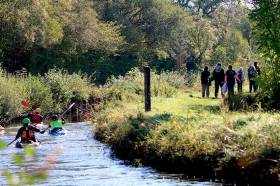Displaying items by tag: National Greenways Strategy
#InlandWaters - Waterways Ireland has welcomed last week’s launch of the National Greenways Strategy by Tourism Minister Shane Ross.
The strategy sets out how national and regional greenways in Ireland should be planned and constructed, and is backed by a fund of €53 million for the years 2019 to 2021.
“I am delighted to be launching this strategy today in our Hidden Heartlands,” Minister Ross said last Friday 20 July, “That brand, and indeed our other tourism brands all identify activity tourism as a key sector for sustainably growing tourism numbers in Ireland.
This strategy, is, I know, eagerly awaited around the country. People have seen the benefits that have accrued to towns along our greenways to date, examples such as Newport on the Great Western Greenway, Kilmacthomas on the Waterford Greenway and here in Moate along the Old Rail Trail.
“Our goal is to replicate the success of those towns and those greenways in other locations around the country. That is why we are focussing our investment on projects of scale, the common denominator of successful projects to date is that they are in the order of 40km and thus provide the opportunity to overnight in a new area.”
The strategy sets out the importance of early and widespread consultation with landowners and communities along and adjacent to proposed greenway routes. It also emphasises the need to minimise the impact on landholdings by minimising severance as far as possible and providing accommodation works such as fencing and underpasses where required, and sets out the importance of access to scenery and things to see and do in order to attract tourists.
Brendan Griffinm Minister of State For Tourism, added: “We are lucky to live in such a beautiful country and greenways provide an opportunity to experience that beauty up close and at a slow pace.
“Our strategy will help us fund the spine of a network of greenways that can, over time, provide links to the rest of the countryside through quiet roads that will prove attractive to many people cycling. I know that Longford County Council is looking to identify a quiet route from the end of the Royal Canal Greenway in Clondra to Athlone; this will provide a wonderful triangular route from Mullingar along the Royal Canal to Clondra and then to Athlone returning to Mullingar on the Old Rail Trail.
“We must also remember that greenways are for more than people cycling. Statistics from our current greenways show that in towns such as Moate there are more people walking than cycling and the important health benefits that accrue to users are another huge benefit for our country.”
Minister Ross concluded: “I am looking forward to examining the many worthwhile project proposals that we expect to receive over the coming months under the funding call, and I would urge local authorities and state agencies to consult widely with landowners and communities along proposed routes to bring agreed routes to fruition. This strategy sets out how that consultation should take place and suggests the components that make for a successful greenway.”




























































